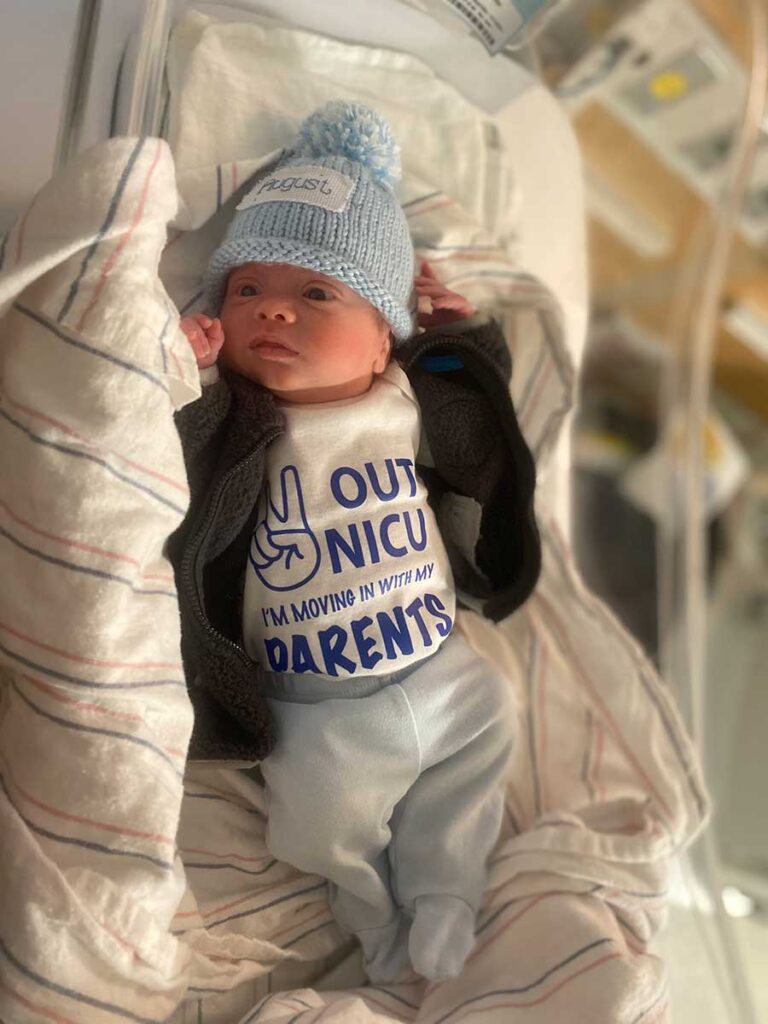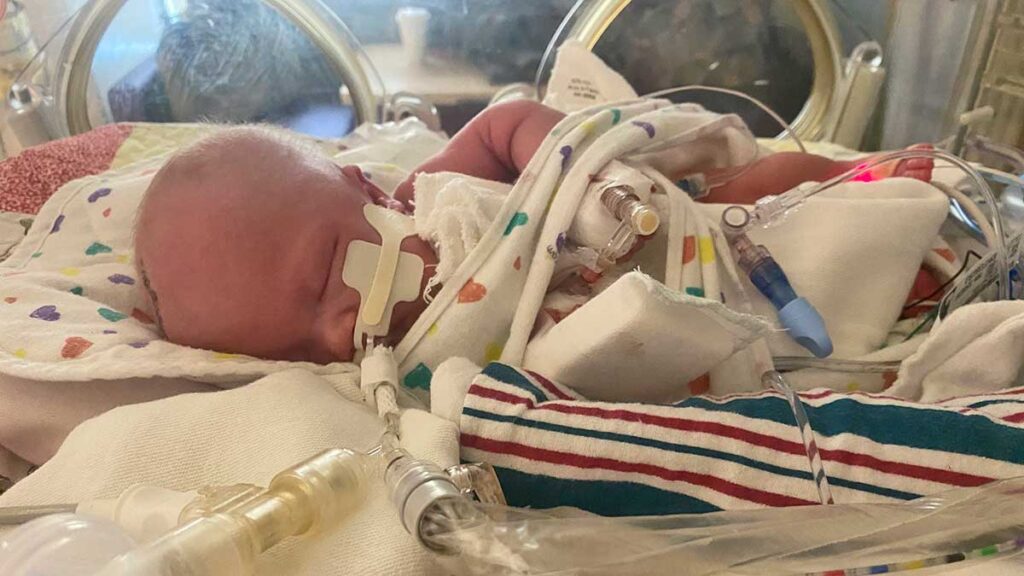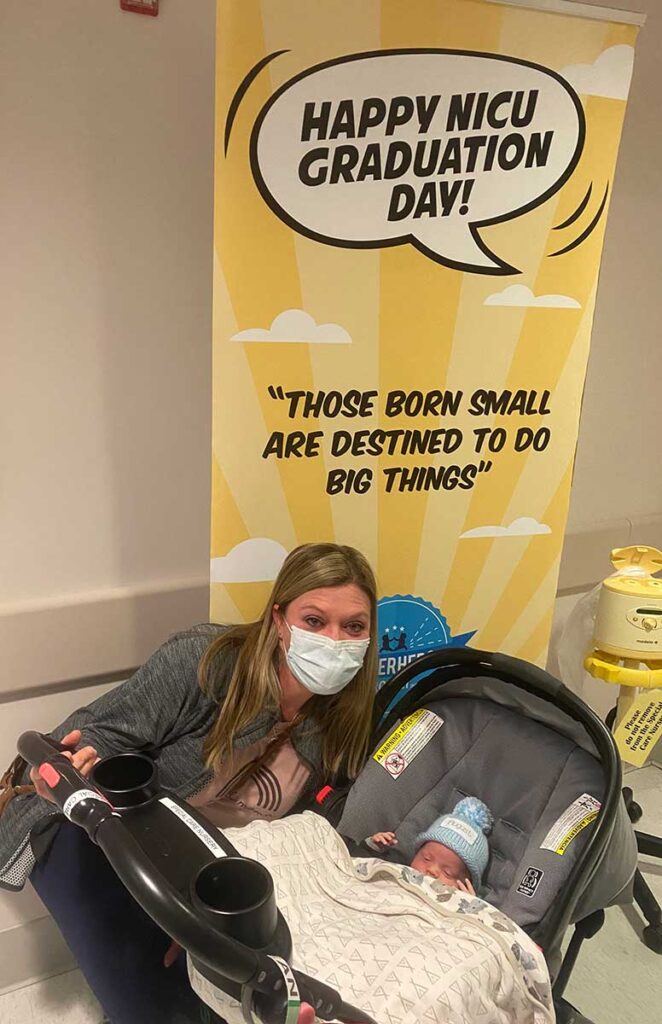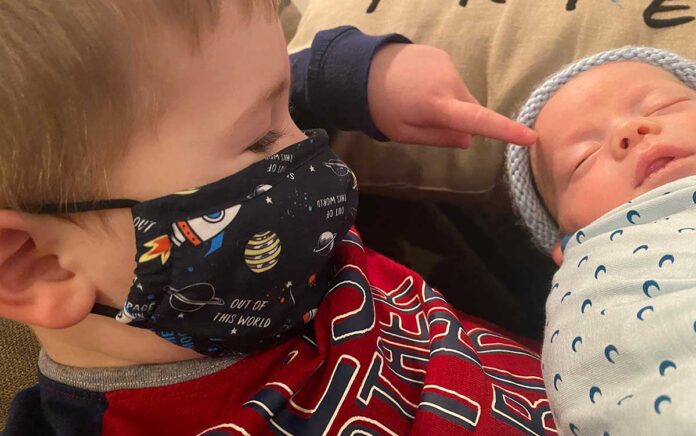Over the last two years, our world has been marked by chaos, crisis and confusion stemming from the COVID-19 pandemic, and in the past two months, that unstable environment has been echoed on a microcosm through our experience delivering our twins, Avery and August, to the NICU. But, as we’ve all likely seen through the pandemic, any significant challenge can yield greater understanding of yourself and your surroundings and a new perspective for taking on obstacles.
With that, here are just a few ways the pandemic has helped our family get ready to cope with what has been our biggest obstacle yet.

Take care of yourself first
At the start of the pandemic, Jackson’s daycare closed for several months, so I became a newly remote worker with an 18-month-old son in tow; meanwhile, Ashlee was working on the COVID floor at the local hospital. We were overwhelmed, to say the least, and the pace we were trying to keep up quickly burnt us both out.
We were having trouble sleeping, couldn’t focus on any one task at a time, and experienced physical symptoms like constant heart palpitations — all of which were influencing our ability to be present as parents for Jackson. Recognizing I couldn’t keep up that pace forever — and as there was no end in sight for the pandemic — I started taking small steps toward self-care: choosing a few extra minutes of sleep over the 6 a.m. wake-up call to cram in extra work, signing off during Jackson’s naptime for a quick YouTube yoga session, forcing myself to listen to two 10-minute meditation sessions each day. Over time, those practices helped me hone my focus, calm my mind and see through the stress to the other side.
Since we became NICU parents, I’ve been trying to fall back on those practices (though it is admittedly harder now!). It’s so easy to lose yourself running from hospital to hospital and trying to be there simultaneously for three kids, but NICU parents have to be good to themselves — in order to be good to those kids.
Know your limits
Early on in our NICU experience, we thought that being good to our kids meant being with them constantly. With August in a hospital near home and Avery receiving care an hour away, we spent many a day driving up and down I-95 to see both, eating hospital food and holding tiny hands through isolettes. We were so physically, mentally and emotionally spent by the time we got to Jackson’s preschool to pick him up that we had barely anything left to give him. Ultimately, we had to forgo our plan to do the daily NICU tour and instead commit to seeing each of them every other day — and waving the white flag and staying home every now and then if we were too spent.
It was a decision that I think I came to more seamlessly because of what I had already learned through the pandemic. At the beginning of that crisis, I was trying to keep up with all of my normal routines and rules: four walks for the dog a day, no TV for Jackson outside of a bit in the morning and at night, getting the wash folded and away fresh out of the dryer. I got to a point where I had to start drawing some lines and bending others for my sanity, and I’ve revisited those lines many times in our new situation.

The small things don’t matter
When I switched to remote work in March 2020, I was terrified of how I was going to pull it off: How would Zoom meetings with Jackson work? How would I keep him on his same daycare schedule? What about all those work deadlines coming up? Then I got to see the gravity of the global crisis from Ashlee’s firsthand perspective — patients dying, healthcare workers sickened. Do those calls, routines and deadlines really matter all that much? Like so many others, we ditched the mundane and went into survival mode.
We got right back there when the twins were born, and actually even before. At the beginning of my pregnancy, I was preoccupied with admittedly dumb things like conceiving of the perfect photo op for a pregnacy announcement. Then, we got the news it was twins and I saw the triviality of my former focus. But now I was faced with new dilemmas: What kind of cribs do we need? Does this mean I’ll have to breastfeed? How will we pay for daycare? How will they sleep — how will we sleep?
Then, the bad news about my pregnancy started rolling in and we had a gut check again. Before the outlook got so grim, I had gone around and meticulously measured every inch of the nursery, drawn out maps of where cribs and dressers would go, plotted out decor; yet now, the twins are over two months old and we have cribs but no mattresses, nothing on the walls, a pile of pieces that will one day be a dresser, stacks of clothes — and I don’t care. All of my ideas about what mattered went out the window when we went back into survival mode.
Just like with COVID, there was suddenly this big, scary cloud looming over us that threatened our (their, in this case) existence but that has thankfully also cast a shadow on all the stupid things I used to think were important and illuminated instead what actually should matter. We’re all alive? Check. The rest will fall into place.

There’s freedom in giving up control
When you’re in survival mode, part of moving forward is accepting that you largely can’t control what’s happening. That’s been one of the hardest aspects of both the NICU and COVID for me — but I’ve also seen that, when I can manage to relinquish control, it’s actually liberating.
Throughout our NICU experience, Google has been my go-to when it comes to the twins’ health. Survival rate of an intestinal perforation? Google it. Complications of hydrocephalus? Google it. Risks of heart surgery on a 3-pounder? Google it. With so many uncertainties and so much medical knowledge outside of our comfort zone, we’ve often sought to arm ourselves with info to take back control of this spinning maelstrom. But after countless instances of finding contradicting advice and losing hours to anxiety-fueled scrolling of research studies far beyond my comprehension, I had to tell myself to chill. Googling won’t change the outcomes other than raising my blood pressure. What I can do is listen to the experts and take it one day at a time.
It’s likely a realization many of us have had throughout COVID. At this point in the pandemic, we’re all weary and desperate for its end, but accepting that that reality is out of our control can free us up to instead be comfortable with the present — doing what we can to protect ourselves, heeding expert guidance and adapting to the changes.
Science in action
One of the arguments many anti-vaxxers or anti-maskers have raised is the changing nature of health officials’ policies and perspectives on the pandemic — from what type of mask is best to the length of quarantine time needed to the number of vaccine doses required. But as leading scientific minds have noted, how we’ve managed COVID is an example of what science truly is: hypotheses followed by data collection followed by analysis and reassessment.
The NICU is no different. Each day, the team of neonatologists, nurses, specialists and more conduct rounds on the floor, gathering at each baby’s bedside to talk about their progress and pitfalls over the previous 12 hours. As observers to this process, we saw the back and forth that would go into every decision made for our babies: Many times, the team would ambitiously elect to ween down one of the twins’ respiratory support but, after a number of respiratory events, would ramp it back up and decide to revisit that step later. When August was struggling to start gaining weight, the docs played with the amount of milk and frequency at which he received it — and when he started gaining too fast later on, they again adjusted until he evened out. At one point, Avery was significantly swollen so was tried on lasix to reduce the edema — and it ultimately dehydrated her and caused other problems, prompting the team to backtrack and try to find a balance. As much as we rightfully put our faith in the babies’ doctors, they’re working with data as it develops — and that’s an eye-opening, albeit incredibly terrifying, aspect of the experience.
Ups follow the downs, and downs may follow the ups
As Omicron is showing us this winter, the COVID curveballs keep coming: We were celebrating higher vaccination rates and lower case counts and then got hit with a whammy from this new variant. I’ve noticed similar yo-yoing in our NICU experience.
Earlier this month, we got the long-awaited news that August would be released from the NICU after a 56-day stay. We got the car seat ready, the house cleaned (I mean, not really), the bottles sterilized and, as we were getting ready to leave for the hospital — nervous but so excited for this day to finally be here — we got a message that one of Jackson’s classmates tested positive for COVID. He was being sent home and couldn’t test for four more days. We were thrown into a tailspin: For two months, we had scrubbed and masked and masked and scrubbed to protect August and Avery and their non-existent immune system from this and other illnesses and here we were, on his release date, possibly bringing him into a den of COVID! Ultimately, after several hours of phone calls and many frustrated tears, the NICU docs advised us to mask at home until we could test (good fun with a 3-year-old!), and after a few days of keeping the boys as far apart as possible and canceling our visitors, we got our negatives — and August finally got to see what an unmasked face looks like for the first time in his life.
Ups and downs have become even more commonplace with Avery. After an incredibly rough start, we started feeling hopeful: She jumped to over 2 pounds and then 3, and she thrived through intestinal and brain surgeries. At a visit a few weeks ago, however, I was jolted back to reality: She needed a new PICC line placed and had to be transported to a radiology lab for the procedure since her veins are so small. It took 12 people crammed into her room just to get her into the transport bed and, in the midst, she started struggling to breathe and needed to be bagged with oxygen. Even now, I’m writing this column from her room, where last night we got a dreaded late night call that she had undergone six minutes of chest compressions to keep her breathing and her heart pumping after a pulmonary hemorrhage. She’s since stabilized, but the ping-ponging of her health has cast a shadow on the hope we’re so eager to feel.
Each wild swing in the twins’ development has brought our emotions right along with it — and we feel these emotions more deeply because of how extreme and contrasting they are. A bad day at the NICU can leave parents yearning for the highs we felt with one of the babies’ small victories or corner turned, while a good day seems even more rewarding after climbing back up from a disappointment. Like COVID, each day is different and all we can hope for is that the good ones outnumber the bad — and eventually the hardest days will be a memory.
